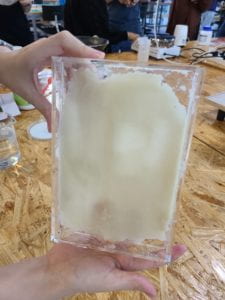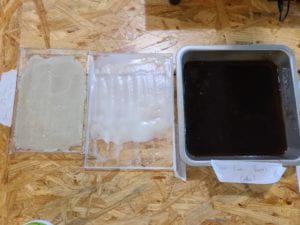- Lab Report 1#
- Title: Making Bioplastic from Potato Starch
- Participants: Tina, Luna, Thomas
- Date: Oct. 7th, 2020
- Introduction and Purpose: This is a recipe offered by Professor Marcela, and it has been tested a lot of times. Therefore, our main purpose to follow this recipe and do the experiment is mainly to make us more familiar with the bio-plastic materials and set the base for our own design.
- Ingredients: 100ml water, 10ml Vinegar, 10g Glycerol, 15g corn starch
- Method: First of all, we use the electronic scale to weigh the Glycerol and corn starch one by one. Then, we first mix the corn starch with the 100ml water slowly. After that, we add the Vinegar slowly to the mixture. Later on, we put the mixture in the pot which has been already heated up to about 200 degrees Celsius, and started to add Glycerol which will soon make the mixture sticky. However, we did not really master the approach to maintain the pot at the same heat level, so in the process, the heat went up very quickly. Therefore, we tried to repeatedly turn the heat on and off a few times while stirring our ingredients into a fully sticky mixture.
- Results: By putting the ingredients in the right proportion, we are able to produce bioplastic materials by ourselves.
- Discussion or Analysis: During the experiment, I found out that strictly following the recipe was quite hard. Some of the causes stem from our unfamiliarity with the experimental equipment and the equipment’s not-sophisticated-enough calculations. Therefore, I am thinking that to produce bioplastic with better qualities, we may need to do more preparations before we really get down to it.
- Conclusions: Generally speaking, everyone is capable of making bioplastic materials by themselves as long as they know some recipes and have the ingredients and measuring tools with them.
- Figures, photos, and Graphs: See Below
- References: Recipes given by Professor Marcela
- Lab Report 2#
- Title: Making Bioplastic from Chitosan
- Participants: Tina, Luna, Thomas
- Date: Oct. 7th, 2020
- Introduction and Purpose: This is a recipe offered by Professor Marcela, and it has been tested a lot of times. Therefore, our main purpose to follow this recipe and do the experiment is mainly to make us more familiar with the bio-plastic materials and set the base for our own design.
- Ingredients: 20ml water, 5ml Vinegar, 10ml Gelatin, 10g Chitosan
- Method: First of all, we use the electronic scale to weigh the Chitosan. Then, we first mix the corn starch with the 20ml water slowly. After that, we add the Vinegar slowly to the mixture. Later on, we put the mixture in the pot which has been already heated up to about 80 degrees Celsius. Then, instead of adding Gelatin as the recipe said, we chose to use its substitute, Glycerol, since we did not find the Gelatin. However, it was hard for us to accurately calculate the amount of Glycerol that we need without knowing the density of Glycerol and Gelatin. Therefore, we had no choice but to estimate that we need 10g Glycerol. Later on, we got down to stir the Glycerol together with the previous-made mixture in the heated pot.
- Results: By putting the ingredients in the right proportion, we are able to produce bioplastic materials by ourselves.
- Discussion or Analysis: During the experiment, I found out that the recipe for making bioplastic was quite flexible. However, producing bioplastic materials on an industrial scale does need a fully experimented recipe and strictly following the recipe step by step. Also, for the chitosan, there is already a lot of researches writing about it. According to one of the researches, chitosan is an ideal material for making plastic that contains food.
- Conclusions: Generally speaking, everyone is capable of making bioplastic materials by themselves as long as they know some recipes and have the ingredients and measuring tools with them.
- Figures, photos, and Graphs: See Below
- References: Recipes given by Professor Marcela; “壳聚糖:比塑料更环保的食品包装材料.” Cell杂志, cell.bio1000.com/cell-reports/202009/0267507.html.
- Lab Report 3#
- Title: Making Bioplastic with Coco-powder
- Participants: Tina, Luna, Thomas
- Date: Oct. 7th, 2020
- Introduction and Purpose: After finishing two experiments based on the recipes given by Professor Marcela, we are finally able to design our own recipe and do the experiment with several potential bioplastic materials.
- Ingredients: 200ml water, 10ml Vinegar, 20g Glycerol, 15g Coco-powder
- Method: First of all, we use the electronic scale to weigh the Glycerol and the coco-powder. Then, we mix the coco-powder with the 200ml water slowly, as we have done in the previous two experiments. After that, we add the Vinegar slowly to the mixture. Later on, we put the mixture in the pot which has been already heated up to about 100 degrees Celsius. However, we found out that we had added too much water, therefore, we tried to lift the heat level up a quite bit to nearly 180 degree Celsius in order to evaporate some of the water. Then, we started to add Glycerol while stirring all the materials together. However, maybe because of the excessive amount of water poured in, the Glycerol did not show that great impact in making the mixture sticky than before. Therefore, we started to add more Glycerol. In the process, Professor Marcela also gave us the suggestion that we should find a thicker container to pour our mixture in so that the bioplastic material we created would not be too thin after the water evaporated. And we follow her instruction.
- Results: Since it requires quite a long time for our material to dry and shape, we did not have the chance to see how it looks like in the end, but we know the fact that designing a recipe for making bioplastic is never an easy task. Instead, we need to acquire more knowledge about the specific material that we are going to use as well as do the experiments again and again to reach the best proportion and recipe.
- Discussion or Analysis: During this first try at designing a recipe and creating a new bioplastic material, I found the process quite interesting. Also, I observed that in the process of making bioplastic, glycerol plays a really important and irreplaceable role.
- Conclusions: Generally speaking, everyone is capable of making bioplastic materials by themselves, but in order to make bioplastic with enough good quality that can make clothes or packing boxes, there is still a long way to go, and much more researches and experiments are needed.
- Figures, photos, and Graphs: See Below
- References: Recipes given by Professor Marcela.


Leave a Reply